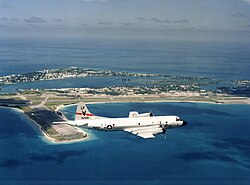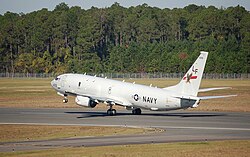VP-16
| Patrol Squadron 16 | |
|---|---|
 VP-16 insignia | |
| Active | May 1946 - present |
| Country | United States of America |
| Branch | |
| Type | squadron |
| Role | Maritime patrol |
| Nickname(s) | War Eagles |
| Engagements | Vietnam War |
| Aircraft flown | |
| Patrol | PV-2 PBY-5A/6A P2V-2/3/5/5F/SP-2E P-3A/C P-8A |
VP-16,nicknamed theWar Eagles,is an activePatrol Squadronof theU.S. Navy.It has been based atNAS Jacksonville,Florida since its founding in 1946. The squadron's mission is to operateMaritime patrol aircraftto the fleet in support of national interests.[1]The squadron's radio callsign is "Talon,"and their tailcode is" LF. "Originally established asReserve Patrol Squadron 906 (VP-906)in May 1946, it was redesignatedMedium Seaplane Squadron 56 (VP-ML-56)on 15 November 1946, redesignatedPatrol Squadron 741 (VP-741)in February 1950 and redesignatedPatrol Squadron 16 (VP-16)on 4 February 1953. It is the third squadron to be designated VP-16; thefirst VP-16was redesignated VP-41 on 1 July 1939 and thesecond VP-16was redesignated VPB-16 on 1 October 1944.[2]
History
[edit]



- VP-906 was established in May 1946 as a reserve squadron, home-ported at NAS Jacksonville, Florida, under the operational control of FAW-11 and administratively under Naval Air Reserve Training Command. The squadron was one of 21 reserve patrol squadrons established after the war to accommodate the large number of aircrews recently released from active duty, utilize the enormous stocks of aircraft in the inventory and serve as a pool of experienced manpower in the event that the newCold Wartensions erupted into actual war. VP-906 flew thePV-2 Harpoonand the amphibiousPBY-5A/6A Catalina.
- 15 November 1946 VP-906 was redesignated VP-ML-56 while atNAS Cecil Field,Florida. Under the new designation system, reserve squadron number designations began with the number 51 and regular Navy squadrons began with 1. All reserve patrol squadrons were designated as ML. The ML designation used by the reserves stood for either Medium Patrol Squadrons flying the twin-engine PV-2 Harpoon or Medium Seaplane Squadrons flying the amphibious PBY-5A Catalina. Regular Navy patrol squadrons flying the PV-2 were designated ML also, but those flying the PBY-5A were designated AM for Amphibian.
- In February 1950 VP-ML-56 was redesignated VP-741 during the reorganization of Naval Aviation reserve units. In this period of extensive defense spending reductions the number of Naval Aviation reserve patrol squadrons was reduced from 24 in 1949 to only 9.
- On 1 Mar 1951 VP-741 was recalled to active duty, the last of the nine reserve patrol squadrons recalled for service during theKorean War.In February 1953 the decision was made to augment all of the nine reserve patrol squadrons activated during 1950 to 1951 as part of the regular Navy. VP-741 was redesignated VP-16. The redesignations did not require changes in tail codes or home ports.
- On 10 Nov 1956, the squadron deployed toNAS Keflavik,Iceland. During theSuez Crisis,the squadron was flying around the clock to protectNATO’s northern flank. After the situation was defused, VP-16 conducted a series of goodwill tours to several European countries before returning to the U.S. in April 1957.
- Mar 1960: VP-16 deployed toNS Roosevelt Roads,Puerto Rico, and participated in Operation Springboard 1960.
- May 1960: The squadron participated in test shots of theRedstoneandAtlasmissiles as part of Task Force 140,Project MercuryRecovery Force.
- 12 Dec 1960: VP-16 deployed toNAS Sigonella,Sicily,for a five-month tour of duty, relievingVP-5.The squadron provided shipping surveillance in the Mediterranean Sea for theU.S. Sixth Fleet.
- In January 1961, it was one of several squadrons called on to assist in the search for the Portuguese cruise linerSanta Mariaafterit had been hijackedby opponents of theSalazar regime.
- Between 29 November 1963 and March 1964 seven squadron aircraft operated fromGuantanamo Bay Naval Base,Cuba, to provide surveillance during theCuban Missile Crisis,relievingVP-23.The detachment was itself relieved in March 1964 by VP-11.
- 1 Dec 1964: VP-16 relieved VP-49 atNAS Bermuda.This was the first deployment for the squadron in its newP-3A Orionaircraft.
- 23 Mar 1965: The squadron participated in operations involving the launching and recovery of theGemini 3space capsule.
- 15 Feb 1966: A detachment of three aircraft was sent toRAF Ascension Islandin support of the projectApollo-Saturn 201flight, Task Force 140. This operation was the first uncrewed spacecraft of the Apollo series to be fired into suborbital flight by aSaturn rocket.
- On 2 December 1966: VP-17 deployed toNaval Station Sangley Pointin the Philippines. A detachment was based atU-Tapao Royal Thai Navy Airfield,Thailand and participated in theVietnam War.During this deployment the squadron missions includedMarket Time patrolsto interdict supplies by sea from North Vietnam,Yankee Teampatrols, Ocean Surveillance Air Patrol, and Special Ocean Surveillance Air Patrols. Patrols were often conducted within 12 miles of the coasts ofNorth Vietnamand throughout theGulf of Tonkin.The squadron completed over 500 missions during its only tour in the Vietnam zone of operations.
- 12 December 1967: VP-16 deployed toNaval Station Rota Spainin southern Spain, as the first P-3 Orion detachment to operate from a Mediterranean base.
- January 1971: VP-16 retrofitted all of its P-3A aircraft with the DIFAR advanced submarine detection system. In July, VP-16 deployed to NAS Sigonella, to test their newly outfitted DIFAR aircraft. The squadron conducted extensive testing of the new equipment during numerous exercises in the Mediterranean Sea.
- 25 October – 2 November 1983: VP-16 provided several aircraft and crews for patrols in the vicinity ofGrenadaduring Operation Urgent Fury, the U.S.Invasion of Grenada.
- August 1985: VP-16 deployed to NAS Bermuda. During the deployment three-aircraft detachments were maintained at NS Roosevelt Roads, to participate in Operation Hat Trick II,drug interdictionpatrols in the Caribbean.
- 10 August 1988: VP-16 deployed to Bermuda, relievingVP-24.The squadron participated in Operation Checkmate 7, interdicting suspected drug trafficking in the Caribbean.[2]
- January 2013: VP-16 become the first U.S. Navy squadron to transition from the P-3C Orion to theP-8A.[3]
- July 2014: Aircraft from VP-16 return home after the U.S. Navy's first ever P-8A Poseidon overseas deployment. Lasting six months, the aircraft were based atKadena AFB,Japan.[4]
Aircraft assignment
[edit]The squadron first received the following aircraft on the dates shown:[2]
- PV-2- May 1946
- PBY-5A/6A- May 1946
- P2V-2/3- 1950
- P2V-5 - February 1955
- P2V-5F - March 1956
- SP-2E - December 1962
- P-3A- July 1964
- P-3A DIFAR - January 1971
- P-3C - August 1973
- P-3C UII.5 - June 1983
- P-3C UIIIR - October 1990
- P-8A- March 2012
See also
[edit]- List of Lockheed P-3 Orion variants
- List of United States Navy aircraft squadrons
- List of inactive United States Navy aircraft squadrons
- List of squadrons in the Dictionary of American Naval Aviation Squadrons
References
[edit]This article incorporates text from thepublic domainDictionary of American Naval Aviation Squadrons.
- ^"U.S. Navy Patrol Squadron Sixteen War Eagles".VP-16 Website.United States Navy.Archived fromthe originalon 26 March 2014.Retrieved3 March2014.
- ^abcRoberts, Michael D. (2000).Dictionary of American Naval Aviation Squadrons, Volume 2, Chapter 3 Patrol Squadron (VP) Histories (2nd VP-9 to 3rd VP-17).Washington, D.C.: Naval Historical Center, Department of the Navy. pp. 91–6.Retrieved26 June2016.
- ^"First Operational P-8A Squadron Prepares for Deployment; Fleet Transition Continues".Retrieved9 August2019.
- ^{{cite web
- 14 March 2018: VP-16 awarded Humanitarian Service Medal by CPRW-11.
- December 2019: VP-16 awarded the Navy "E" Ribbon by Commander, 6th FLEET.|url=http:// gonavy.jp/VP_VP16f.html%7Caccess-date=9August 2019|title=VP-16 Deployment History}}
External links
[edit]

